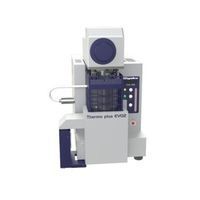Rigaku - TMA
TMA is the measurement of a change of a dimension or a mechanical property of the sample while it is subjected to a temperature regime.
TMA is the measurement of a change of a dimension or a mechanical property of the sample while it is subjected to a temperature regime.
TMA uses interchangeable probes at varied loads to make a number of measurements, including the softening temperature or glass transition temperature, tensile modulus, compression modulus, the thermal expansion, melting temperature, crystalline phase transition temperature, crystalline to amorphous transition temperatures, and creep under load, by measuring the change of a dimension of a material.
TMA includes several variations according to the attachment probe and the methods of the attachment probe are applied: compression loading, tensile loading, penetration, 3-point bending methods.
Rigaku adopts differential expansion principle where the thermal expansion or shrinkage generated from the detection mechanism itself can be canceled. It offers high accuracy and excellent reproducibility in expansion and shrinkage measurements, even with low expansion materials or thin materials. It can also measure using the non-differential or conventional expansion method.
Dynamic TMA mode that is a temperature control method in which the sample’s shrinkage associated with sintering is measured not by constant heating rate but the heating rate continuously changes depending on the sample’s shrinkage rate. Thru this temperature control, the temperature program simulation can be applied to inhibit grain grows and obtain a sintered material.
Active Questions & AnswersAsk a Question
There are no current Discussions
Need Equipment Support?
Documents & Manuals
There are no Documents or Manuals available.
Features of TMA
- High-sensitivity, high-precision measurement by the differential method
- Multi-measurement system that excels in expandability
- Flexible handling of various sample sizes
- Notable enhancement of heating and cooling rates enabled by a compact electric furnace
- Simple sample setting mechanism, the first of its kind in differential TMA
- Safety foremost emphasized on the entire system
- Different measurement methods
- Compression loading method
- Tensile loading method
- Penetration method
- High-sensitivity differential penetration method
- Measuring temp. range
- Standard model: Ambient to 1100°
- High-temperature model: Ambient to 1500°
General Specifications
There are no General Specifications available.

